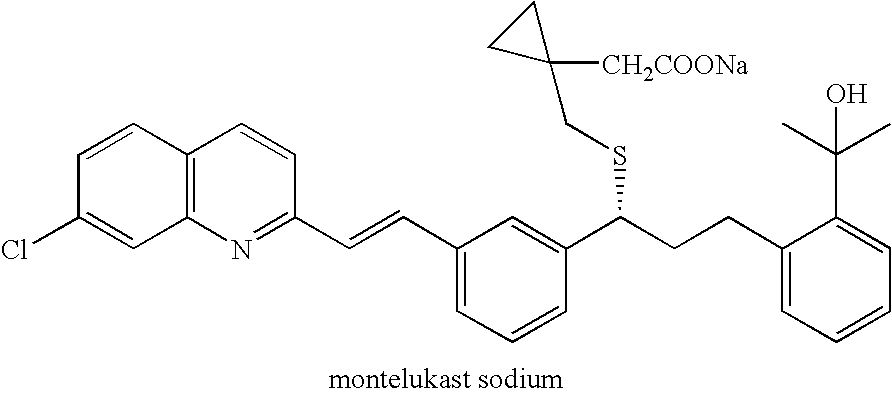Process for preparing 1-(mercaptomethyl)cyclopropaneacetic acid, a useful intermediate in the preparation of montelukast and salts thereof
a technology of cyclopropaneacetic acid and mercaptomethyl cyclopropane, which is applied in the field of synthetic process and novel intermediate for preparing the sidechain precursor 1(mercaptomethyl) cyclopropaneacetic acid, which can solve the problems of unfavorable industrial use of sodium cyanide or thioacetic acid, limited stability, and long process steps
- Summary
- Abstract
- Description
- Claims
- Application Information
AI Technical Summary
Benefits of technology
Problems solved by technology
Method used
Image
Examples
example 1
Preparation of 1-(bromomethyl)cyclopropane-acetonitrile
[0077]A 500 ml 3-necked flask equipped with a thermometer, a dropping funnel and a magnetic stirrer was charged with 74.8 g (0.28 mol) of Ph3P and 300 ml of acetonitrile, and was cooled to −8° C. under stirring. 43.2 g (0.27 mol) of bromine was added drop-wise at a temperature range of −10˜0° C. The mixture was stirred at a temperature range of 0-5° C. until the yellow color disappeared. Then, 24.4 g (0.22 mol) of 1-(hydroxymethyl)cyclopropaneacetonitrile (IV) was added drop-wise at a temperature below 10° C. The reaction mixture was then heated to 60° C. for 15-20 minutes. The solution was cooled to a temperature below −10° C. for at least 1 hour and then the solution was filtered. The thus formed cake was washed with 2×100 ml of cold acetonitrile. The filtrate was concentrated to dryness and to the residue was added 100 ml of MTBE and the mixture was stirred at −8˜3° C. for at least 1 hour. The mixture was then filtered and th...
example 2
Preparation of 1-(isothiuroniummethyl)cyclopropane-acetonitrile hydrobromide
[0079]A 500 ml round bottomed flask equipped with a condenser was charged with 32.6 g (0.187 mol) of 1-(bromomethyl)cyclopropaneacetonitrile, 165 ml of acetone and 14.4 g of thiourea and the mixture was stirred and heated to reflux for 12 hours. The reaction mixture was cooled to −8˜3° C. and stirred for at least 1 hour and then filtered to obtain a cake, which was washed with 2×50 ml of cold acetone. Then, the vessel containing the cake was charged with 87 ml of acetone and slurried for 5 hours. The mixture was filtered and the thus formed cake was washed with 2×25 ml of cold acetone. After being dried under vacuum, 42.6 g of 1-(isothiuroniummethyl)cyclo-propaneacetonitrile hydrobromide was obtained as a white solid in 91.1% yield, having a purity of 99.2%, m.p. 156° C.
[0080]1HNMR (DMSO-d6) δ 9.22 (s, 2H), 9.06 (s, 1H), 3.38 (s, 2H), 2.73 (s, 2H), 0.70 (s, 4H); 13CNMR (DMSO-d6) δ 169.57, 169.51, 38.46, 23.2...
example 3
Preparation of 1-(mercaptomethyl)cyclopropaneacetic acid
[0081]A 100 ml 3-necked flask fitted with a thermometer and a condenser mounted with a nitrogen inlet was charged with 10 g of 1-(isothiuroniummethyl)cyclopropane-acetonitrile hydrobromide (0.04 mol) and 38.3 ml of 20% degassed sodium hydroxide solution. The mixture was stirred and heated to reflux for about 14 hours under nitrogen atmosphere. Upon cooling to room temperature, degassed ethyl acetate was added to the mixture, which was then cooled to −5˜5° C. The mixture was neutralized with degassed 85% formic acid until a pH value in the range of 3.5-4.0 was obtained. The organic layer was separated and the aqueous layer was further extracted with degassed ethyl acetate. The combined organic layers were washed with degassed water, dried and concentrated to give the crude 1-(mercaptomethyl)cyclopropane-acetic acid, which was purified by crystallization from hexanes. After drying under vacuum, 4.48 g of 1-(mercaptomethyl)cyclopr...
PUM
| Property | Measurement | Unit |
|---|---|---|
| temperature | aaaaa | aaaaa |
| temperature | aaaaa | aaaaa |
| temperature | aaaaa | aaaaa |
Abstract
Description
Claims
Application Information
 Login to View More
Login to View More - R&D
- Intellectual Property
- Life Sciences
- Materials
- Tech Scout
- Unparalleled Data Quality
- Higher Quality Content
- 60% Fewer Hallucinations
Browse by: Latest US Patents, China's latest patents, Technical Efficacy Thesaurus, Application Domain, Technology Topic, Popular Technical Reports.
© 2025 PatSnap. All rights reserved.Legal|Privacy policy|Modern Slavery Act Transparency Statement|Sitemap|About US| Contact US: help@patsnap.com



